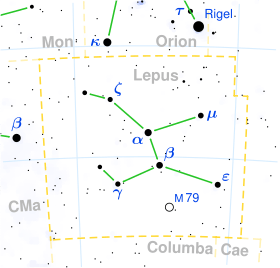Alpha Leporis
Alpha Leporis (α Leporis, abbreviated Alpha Lep, α Lep), formally named Arneb /ˈɑːrnɛb/,[10][11] is the brightest star in the constellation of Lepus.
 | |
| Observation data Epoch J2000 Equinox J2000 | |
|---|---|
| Constellation | Lepus |
| Right ascension | 05h 32m 43.81612s[1] |
| Declination | −17° 49′ 20.2414″[1] |
| Apparent magnitude (V) | 2.589[2] |
| Characteristics | |
| Spectral type | F0 Ib[3] |
| U−B color index | +0.386[2] |
| B−V color index | +0.217[2] |
| Astrometry | |
| Radial velocity (Rv) | +23.9[4] km/s |
| Proper motion (μ) | RA: +3.56[1] mas/yr Dec.: +1.18[1] mas/yr |
| Parallax (π) | 1.47 ± 0.14[1] mas |
| Distance | 2,200 ± 200 ly (680 ± 60 pc) |
| Absolute magnitude (MV) | −6.574[1] |
| Details | |
| Mass | 13.9 ± 0.8[5] M☉ |
| Radius | 129[6] R☉ |
| Luminosity | 32,000[7] L☉ |
| Surface gravity (log g) | 1.34 ± 0.07[5] cgs |
| Temperature | 6,850 ± 80[5] K |
| Metallicity [Fe/H] | +0.04[8] dex |
| Rotational velocity (v sin i) | 21[9] km/s |
| Age | 13[5] Myr |
| Other designations | |
| Database references | |
| SIMBAD | data |
Alpha Leporis is the star's Bayer designation. The traditional name Arneb comes from the Arabic أرنب ’arnab 'hare'[12] ('Lepus' is Latin for hare). In 2016, the International Astronomical Union organized a Working Group on Star Names (WGSN)[13] to catalog and standardize proper names for stars. The WGSN's first bulletin of July 2016[14] included a table of the first two batches of names approved by the WGSN; which included Arneb for this star.
In Chinese, 廁 (Cè), meaning Toilet, refers to an asterism consisting of α Leporis, β Leporis, γ Leporis and δ Leporis.[15] Consequently, the Chinese name for α Leporis itself is 廁一 (Cè yī), "the First Star of Toilet".[16]
This is a massive star with about 14 times the mass of the Sun.[5] The interferometer-measured angular diameter of this star, after correction for limb darkening, is 1.77 ± 0.09 mas.[17] At an estimated distance of 2,218 light-years (680 parsecs),[1] this yields a physical size of about 129 times the radius of the Sun.[6] Alpha Leporis has a stellar classification of F0 Ib,[3] with the Ib luminosity class indicating that it is a lower luminosity supergiant star. Since 1943, the spectrum of this star has served as one of the stable anchor points by which other stars are classified.[18] The effective temperature of the outer envelope is about 6,850 K,[5] which gives the star a yellow-white hue that is typical of F-type stars. It is an estimated 13 million years old.[5]
Alpha Leporis is an older, dying star that may have already passed through a supergiant phase and is now contracting and heating up in the latter phases of stellar evolution, or perhaps is still expanding into the supergiant phase. Based upon its estimated mass, it is expected to end its life in a spectacular stellar explosion known as a supernova. However, this is not expected to happen for another million years. [19]
Arneb in Military
USS Arneb (AKA-56) was a ship of the United States navy.
References
- van Leeuwen, F. (November 2007). "Validation of the new Hipparcos reduction". Astronomy and Astrophysics. 474 (2): 653–664. arXiv:0708.1752. Bibcode:2007A&A...474..653V. doi:10.1051/0004-6361:20078357.
- Gutierrez-Moreno, Adelina; et al. (1966), A System of photometric standards, 1, Publicaciones Universidad de Chile, Department de Astronomy, pp. 1–17, Bibcode:1966PDAUC...1....1G
- Gray, R. O.; Napier, M. G.; Winkler, L. I. (April 2001), "The Physical Basis of Luminosity Classification in the Late A-, F-, and Early G-Type Stars. I. Precise Spectral Types for 372 Stars", The Astronomical Journal, 121 (4): 2148–2158, Bibcode:2001AJ....121.2148G, doi:10.1086/319956
- Evans, D. S. (June 20–24, 1966), "The Revision of the General Catalogue of Radial Velocities", in Batten, Alan Henry; Heard, John Frederick (eds.), Determination of Radial Velocities and their Applications, Proceedings from IAU Symposium no. 30, University of Toronto: International Astronomical Union, Bibcode:1967IAUS...30...57E
- Lyubimkov, Leonid S.; et al. (February 2010). "Accurate fundamental parameters for A-, F- and G-type Supergiants in the solar neighbourhood". Monthly Notices of the Royal Astronomical Society. 402 (2): 1369–1379. arXiv:0911.1335. Bibcode:2010MNRAS.402.1369L. doi:10.1111/j.1365-2966.2009.15979.x.
- Lang, Kenneth R. (2006), Astrophysical formulae, Astronomy and astrophysics library, 1 (3rd ed.), Birkhäuser, ISBN 3-540-29692-1. The radius (R*) is given by:
- Smiljanic, R.; et al. (April 2006), "CNO in evolved intermediate mass stars", Astronomy and Astrophysics, 449 (2): 655–671, arXiv:astro-ph/0511329, Bibcode:2006A&A...449..655S, doi:10.1051/0004-6361:20054377
- Venn, Kim A. (August 1995), "Atmospheric Parameters and LTE Abundances for 22 Galactic, A-Type Supergiants", Astrophysical Journal Supplement, 99: 659, Bibcode:1995ApJS...99..659V, doi:10.1086/192201
- Royer, F.; et al. (October 2002), "Rotational velocities of A-type stars in the northern hemisphere. II. Measurement of v sin i", Astronomy and Astrophysics, 393: 897–911, arXiv:astro-ph/0205255, Bibcode:2002A&A...393..897R, doi:10.1051/0004-6361:20020943
- Kunitzsch, Paul; Smart, Tim (2006). A Dictionary of Modern star Names: A Short Guide to 254 Star Names and Their Derivations (2nd rev. ed.). Cambridge, Massachusetts: Sky Pub. ISBN 978-1-931559-44-7.
- "IAU Catalog of Star Names". Retrieved July 28, 2016.
- Allen, Richard Hinckley (1899), Star-names and Their Meanings, G. E. Stechert, p. 268
- "IAU Working Group on Star Names (WGSN)". Retrieved May 22, 2016.
- "Bulletin of the IAU Working Group on Star Names, No. 1" (PDF). Retrieved July 28, 2016.
- (in Chinese) 中國星座神話, written by 陳久金. Published by 台灣書房出版有限公司, 2005, ISBN 978-986-7332-25-7.
- (in Chinese) 香港太空館 - 研究資源 - 亮星中英對照表 Archived 2008-10-25 at the Wayback Machine, Hong Kong Space Museum. Accessed on line November 23, 2010.
- Richichi, A.; Percheron, I.; Khristoforova, M. (February 2005), "CHARM2: An updated Catalog of High Angular Resolution Measurements", Astronomy and Astrophysics, 431: 773–777, Bibcode:2005A&A...431..773R, doi:10.1051/0004-6361:20042039
- Garrison, R. F. (December 1993), "Anchor Points for the MK System of Spectral Classification", Bulletin of the American Astronomical Society, 25: 1319, Bibcode:1993AAS...183.1710G, retrieved February 4, 2012
- Kaler, James B., "ARNEB (Alpha Leporis)", Stars, University of Illinois, retrieved January 8, 2012